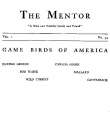You are here
قراءة كتاب The Mentor: Game Birds of America, Vol. 1, Num. 34, Serial No. 34
تنويه: تعرض هنا نبذة من اول ١٠ صفحات فقط من الكتاب الالكتروني، لقراءة الكتاب كاملا اضغط على الزر “اشتر الآن"

The Mentor: Game Birds of America, Vol. 1, Num. 34, Serial No. 34
The Mentor, No. 34,
Game Birds of America
The Mentor
“A Wise and Faithful Guide and Friend”.
Vol. 1 No. 34
GAME BIRDS OF AMERICA
RUFFED GROUSE
BOB WHITE
WILD TURKEY
CANADA GOOSE
MALLARD
CANVASBACK
By EDWARD H. FORBUSH, State Ornithologist of Massachusetts
Author of “Useful Birds and Their Protection,” “A History of Game Birds, Wild Fowl, and Shore Birds,” etc.

YOUNG GROUSE
The young bird learning to perch above the reach of prowling enemies.
North America, when discovered by Columbus, probably contained more game birds than any other continent. The great falling off in the number of these birds in recent times has been accentuated by the extinction of the passenger pigeon and the Eskimo curlew, and the rapid disappearance of many others, among which are the whooping crane and the sandhill crane, great birds that are gradually being swept from the continent. The upland plover, formerly abundant in every suitable grassy region east of the Rocky Mountains, is now facing extinction, and its salvation is beyond hope, unless the regulations, protecting it at all times, recently made by the United States Department of Agriculture, under the Weeks-McLean law, can be enforced. The rails do not appear to have decreased in number quite so rapidly as have the shore birds; but from the king rail, the finest of them all, down to the sora they are much less numerous than in the early years of the last century.
THE RUFFED GROUSE

A RUFFED GROUSE NEST
“Whir-r-r-r-r-r-r—clip-clip-clip—” Heavens! what was that? Anyhow, it’s gone, and nobody’s hurt. How well I recall the startling sound that checked in an instant my headlong pursuit of a baby cottontail rabbit when, from the leaves almost beneath my feet, up sprang a feathered projectile with thundering wings, which sped away in headlong flight through whirling leaves and bending twigs, disappearing in an instant in the thick of the trees. There I (aged eight) stood, gazing after this new wonder, while little Cottontail made good its escape. I had seen my first grouse, the king of game birds.

YOUNG GROUSE
Confident that they are hidden from the camera man.
In the North this grouse is known as the partridge; Southerners recognize it as the pheasant; but how few of us know more about it! How few realize that it flies quietly when undisturbed, or that it has a variety of notes, ranging from the soft, cooing mother’s call to the harsh scream or squeal with which she hurls herself at some enemy of her brood. Many have heard the drumming of the male, “Thump—thump—thump—thump, thump; thump, thump-rup, rup rup rup r-r-r-r-r-r-r-r-r”; but how many know that some seasons in some localities they do not drum at all? And why not?

RUFFED GROUSE ON


